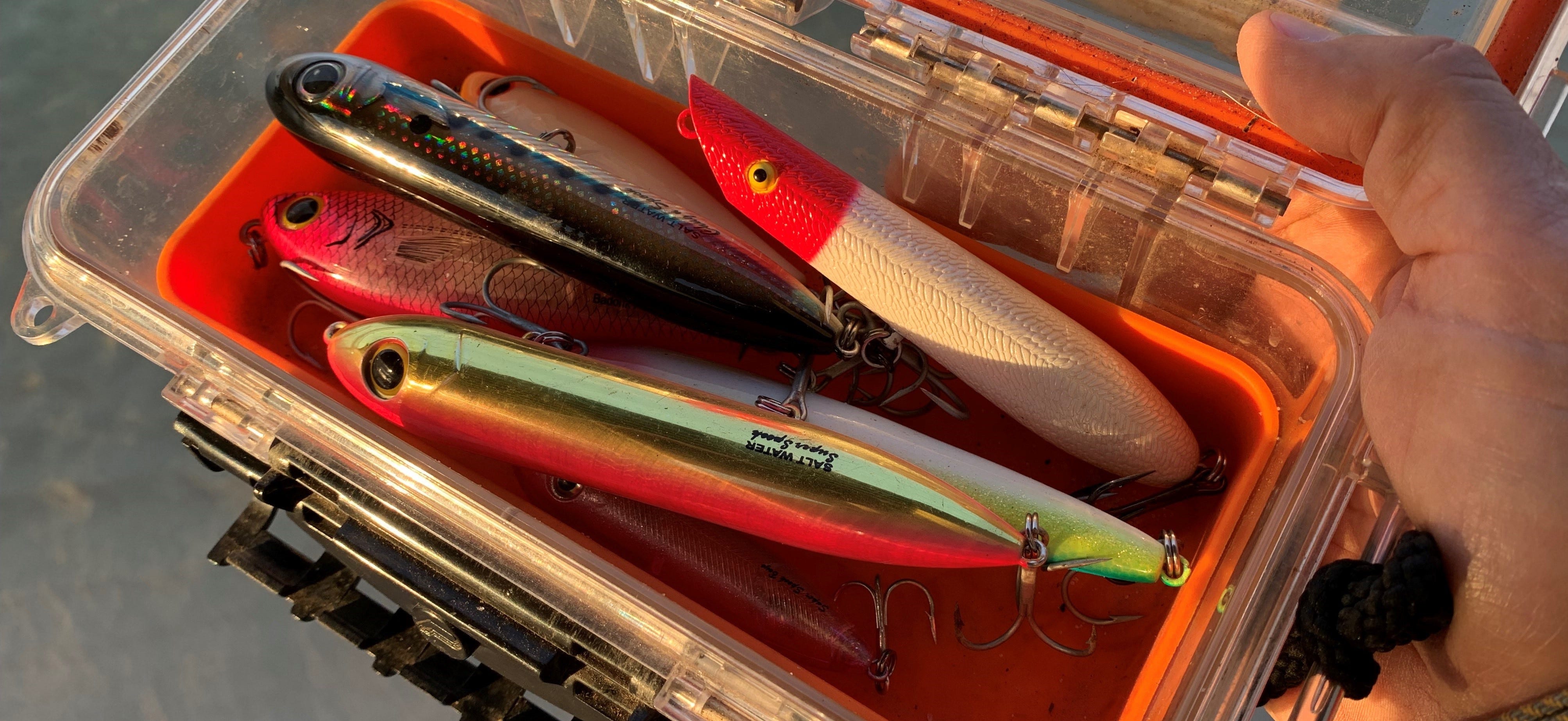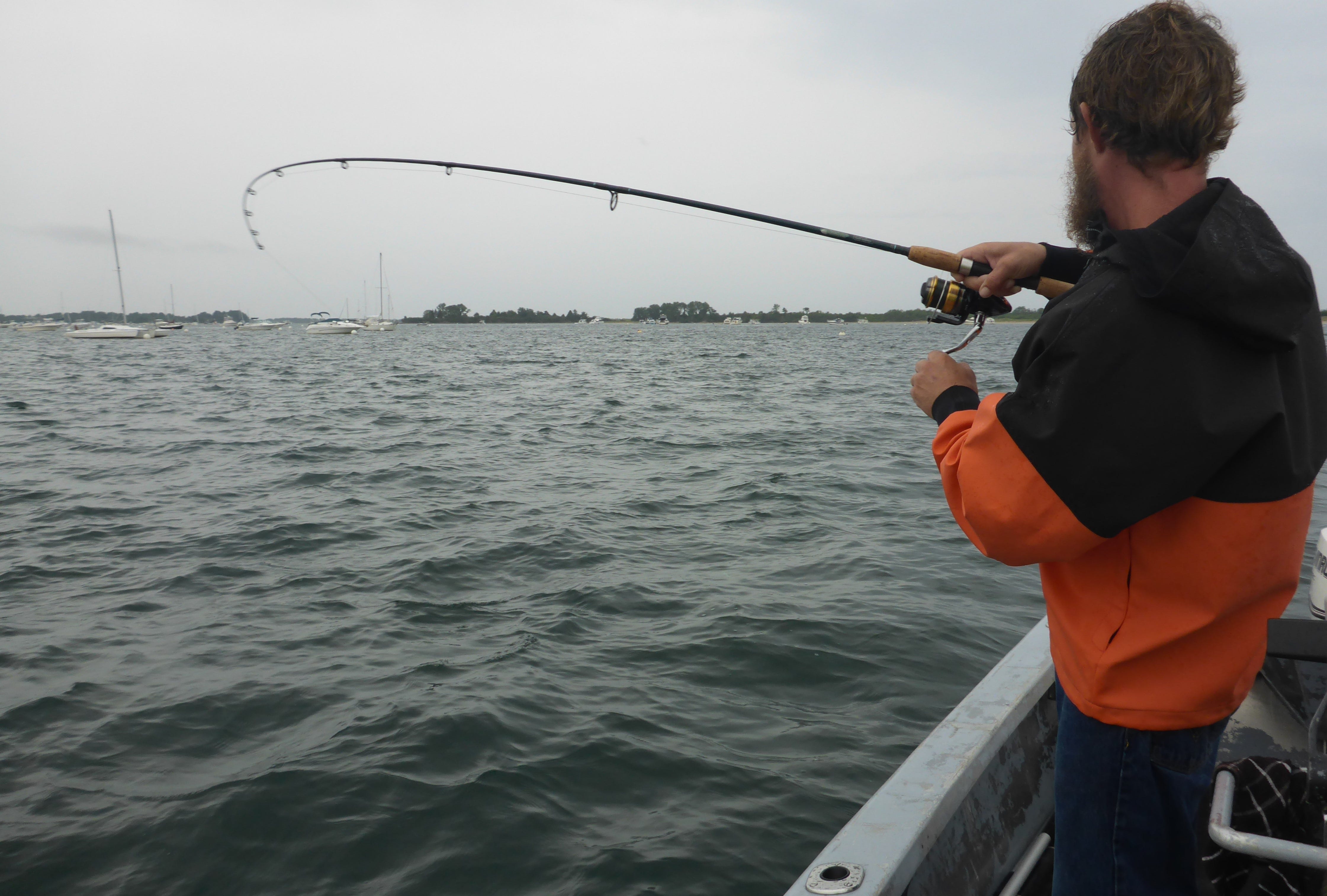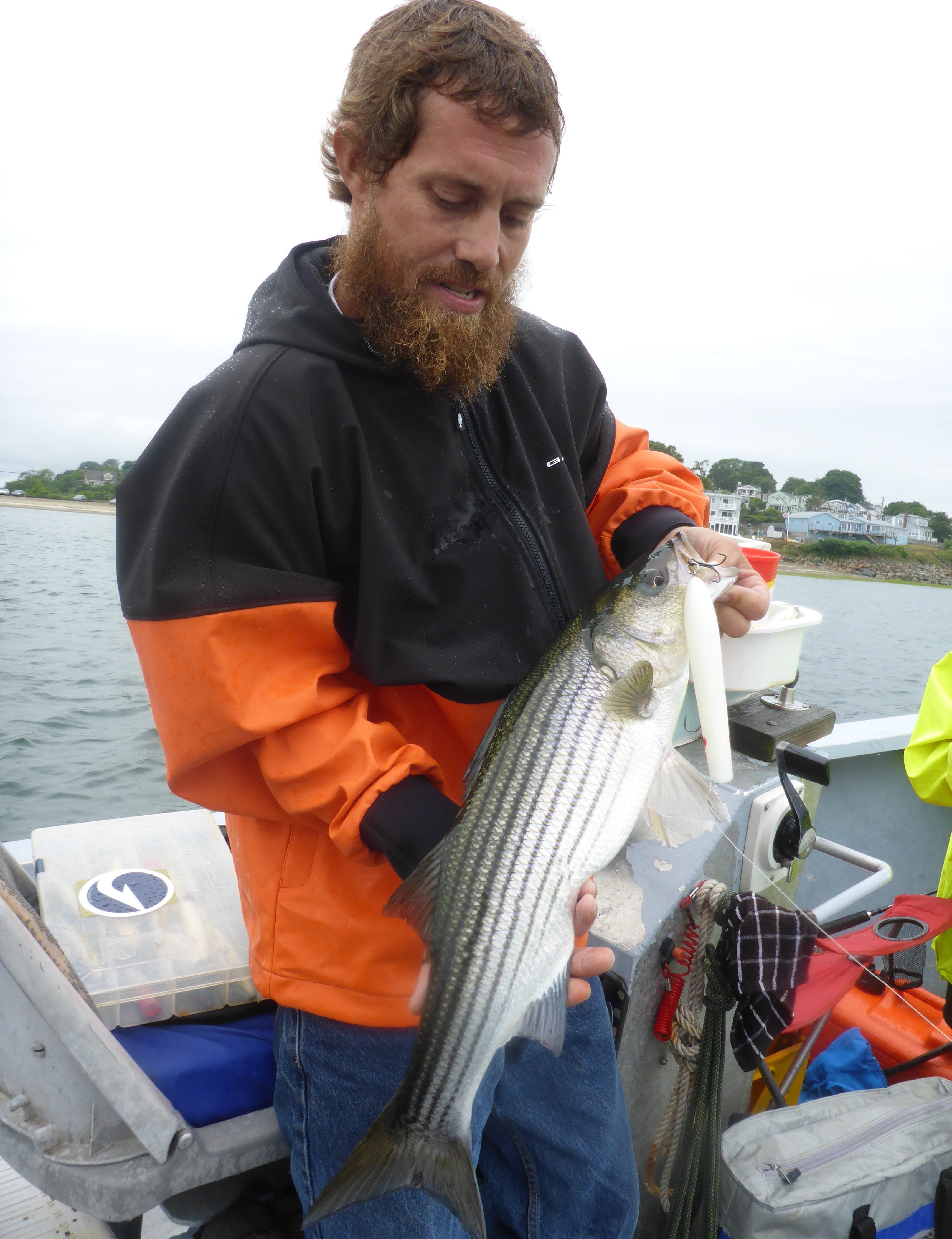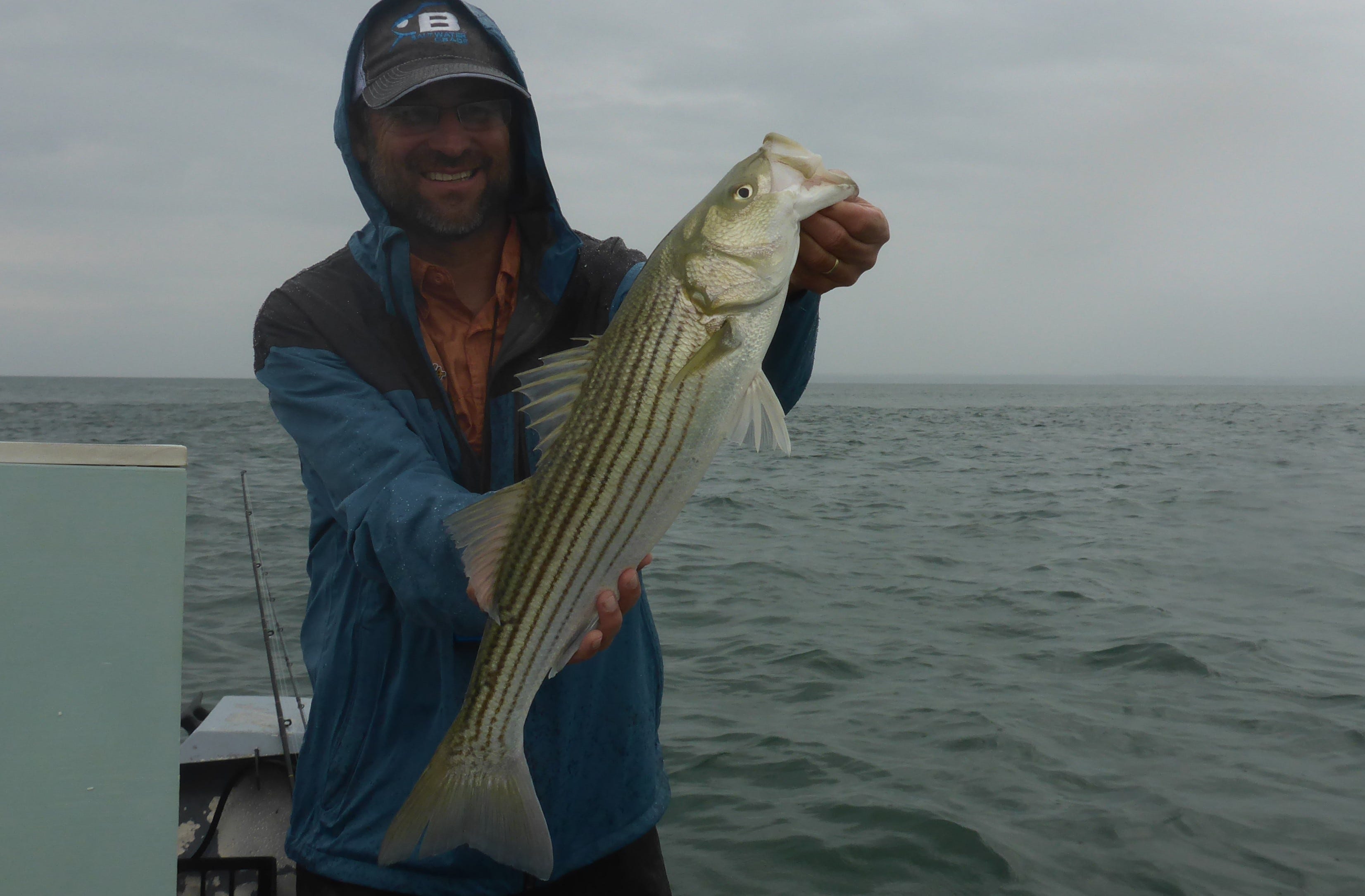- Sep 30, 2022
Walk the Dog Topwater Tactics for East Coast Stripers
This is the best time of the year for exciting top-water action from the surf, inlet or boat while casting walking topwater lures!
Some things just belong together like peanut butter and jelly, baseball and hotdogs, pencil poppers and striped bass fishing. Consider fall, when weather patterns are often ideal, with clear skies and calm waters – from the surf to farther out—and you have the perfect conditions to cast and retrieve your best selection of topwater striper lures, including Cotton Cordell Pencil Poppers, Rebel Jumpin’ Minnows and Heddon Super Spooks.
Gone for now are the blustery conditions of recent months. High barometric pressure from fronts often means you’ll be able to fish in an ocean that looks more like your local freshwater lake or pond. And there is no better time than to pull out one of your most effective lures, walking topwater lures! What exactly are these lures, and why are they so effective for striper fishing? Let’s take a look.
Topwater Favorites


Pencil Poppers, the most popular type of topwater lures for striper fishing, – are aptly named, as they resemble, to some degree, the simple writing tool – although not exactly. Look at the Cotton Cordell Pencil Popper, and you can see it does resemble pencil—but a very thick pencil! The other important features that distinguishes a Pencil Popper is its cupped face, which causes it to pop or chug as you work it, whether by walking it from side to side, sweeping it to chug straight or reeling quickly to churn the water like a big fleeing baitfish.
Other walking topwater lures, such the Heddon Spooks, Rebel Jumpin’ Minnows and Bomber Badonk-A-Donks, look similar, but lack the popping face. Each one comes with different features and differences in shaping and action, but all are meant for long casts and eliciting strikes by imitating a wounded or sick baitfish as they dart from side to side.
The Pencil Popper comes in 4 1/2-, 6- and 7-inch sizes. The smallest is ideal for calmer conditions and bay or inlet fishing. The larger two sail long distance and offer a big commotion and profile in the surf. The Jumpin’ Minnows T20 is 4 1/2 inches long and another good pick for calmer conditions and smaller water. The Bomber Badonk-A-Donk, also designed to walk on top, comes in low-pitch and high-pitch versions.
The 5-inch Heddon Super Spook is versatile in applications, being large enough and noisy enough to be effective in the surf. The Heddon Spook family actually includes multiple models, all designed to walk, but each a little different. Other Spooks that are very well suited for striper fishing include Saltwater Chug’n Spooks and One Knocker Spooks.
Popular colors include red/white, yellow, bone and silver/black or blue combinations. I prefer colors that are easy to see during my retrieve—and colors I “think” the fish will see just as well, or that resemble whatever baitfish is present
Balance Fishing Outfits are Key


Pencil Poppers are meant for casting. Large sizes, narrower fronts and weighted, bulbous back ends allow you to fling them long distances out in search of stripers. The Cordell Pencil Popper has a weighted back end for extra-long casts. Super Spooks likewise are engineered for long casts.
To get the most of your casting skills and to work lures right, you will need the correct fishing combination! Whether you’re fishing from shore, an inlet or jetty or a boat will determine the rod length you should use. Surf-fishermen will need a rod of 8 to 9 or even 10 feet long, with a medium to heavy action—but the key to casting top-water plugs is in your rod’s tip. A whippy end of your rod is necessary to get the most distance and with accuracy, too. Shore-based and boating anglers can go with a 7- to 8-foot combination with medium action, since most casts will not need to be as long; however, the same characteristics of a rod with a whippy tip is still in play.
Your reel needs to be up to the task as well. Heavy-duty spinning reels of years back are still effective tools, but with the advent of braided lines and graphite rods, many anglers have successfully switched to intermediate reels that can hold between 200 to 250 yards of 40- to 50-pound braid. Look for a reel that can provide at least 15 pounds of drag and with new-age washers that will dissipate heat from a searing run of a cow striper. Check in with a tackle shop that specializes in saltwater gear for hands-on advice.
Many seasoned anglers prefer a reel with a high gear ratio from 5 or 6 to 1; the reason being higher gear ratios help you to work the lure more effectively when combined with twitching your rod and retrieving. Ratios simply mean the number of times the bail goes around the spool with one turn, so a 5 to 1 ratio means one turn of the reel handle equals five bail spins. More line is retrieved at higher ratios. When it comes to fishing topwaters lures during fall season, higher gear ratios allow for better presentations.
Cast With a Goal in Mind


When room allows, such as an open stretch of beach with few other fishermen around, many of us will cast as far as we are able. Although it’s not necessarily a bad idea to cast as far as you can and then work your lure back — sometimes it’s better to work your way out while casting. The idea is you won’t spook any close-by stripers with a long cast, and it’s easier to fight a fish that’s hooked closer; however, sometimes you’ll need to cast out to where baitfish are schooling, or birds are working. And that’s where topwater baits really are worth their weight in gold! You can cast long distances fast to reach out and land where the bass are feeding.
Be sure to fan-cast your lures to cover all the available water around you. Vary your retrieve, but keep in mind, it’s important to impart a splashing frenzy, creating commotion with your lure. Walking the dog, as is commonly said, means creating a back-and-forth motion on your lure that imitates a baitfish that is trying to regain its balance in the water. It’s achieved by repeatedly snapping the rod tip with a semi-slack line. Quick, short snaps cause the bait to go back and forth with a tight action. Longer sweeps cause it to glide from side to side.
Reel to take up line, but move the lure mostly with the rod. Occasionally bring the presentation to a brief stop, especially if you see a bass hit your lure and miss it! Get ready for a thunderous strike that will make your heart miss a beat or two!
With large Pencil Poppers, specifically, sometimes the best way to impart hard striper strikes is to make a long cast and reel back quickly, with the rod tip low and adding some jerks – so the popping face digs and chugs and the lure races along like a frantic baitfish.
There’s no more exciting time than the fall season to be out on the water after striped bass! Topwater baits provide fun fishing and heart-stopping visual action when you see a cow striper – or any striper for that matter – come up to inhale your offering! Seconds later your line will tighten, your reel will sing and your heart will race—and isn’t that why you’re out there in the first place?! Enjoy the fall season before it ends.
Possible Hook & Hardware Modifications


- Flatten treble hook barbs for easier hook removal
- Remove rear treble hook and replace with 2/0 circle hook
- Replace factory treble hooks with one size larger treble hooks of thicker gauge



